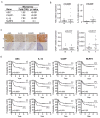ASC contributes to metastasis of oral cavity squamous cell carcinoma
- PMID: 27367024
- PMCID: PMC5226569
- DOI: 10.18632/oncotarget.10317
ASC contributes to metastasis of oral cavity squamous cell carcinoma
Abstract
ASC (Apoptosis-associated Speck-like protein containing a CARD) acts as a platform protein in the inflammasome cascade of some cancer types. However, its potential involvement in OSCC (oral cavity squamous cell carcinoma) has not yet been determined. Here, we investigated the potential role of ASC in OSCC. RT-qPCR analysis of 20 paired tumor and adjacent normal tissue samples revealed that the mRNA levels of ASC, along with IL-1β, CASP1, and NLRP3 in ASC-associated NLRP3 inflammasome were significantly elevated in OSCC tissues. Immunohistochemical staining of these four proteins in 111 clinical specimens revealed that high-level expression of ASC was significantly associated with tumor stage, node stage (p=0.001), overall stage (p<0.001), extracapsular spread (p<0.001), perineural invasion (p=0.004) and tumor depth (p<0.001). Kaplan-Meier survival analysis further revealed that high-level ASC expression was correlated with poorer overall survival (p=0.001), disease-specific survival (p<0.001) and disease-free survival (p<0.001). Studies using OSCC cell lines indicated that high-level ASC expression enhanced cell migration and invasion, and experiments using an orthotropic nude mouse model confirmed that ASC overexpression induced metastasis of OSCC cells. This is the first report to show that ASC contributes to OSCC metastasis, and that high-level ASC expression is a marker for poor prognosis in OSCC patients.
Keywords: ASC; OSCC; metastasis.
Conflict of interest statement
The authors report no potential conflict of interest.
Figures



Similar articles
-
The role of NLRP3 inflammasome in 5-fluorouracil resistance of oral squamous cell carcinoma.J Exp Clin Cancer Res. 2017 Jun 21;36(1):81. doi: 10.1186/s13046-017-0553-x. J Exp Clin Cancer Res. 2017. PMID: 28637493 Free PMC article. Clinical Trial.
-
CMTM3 inhibits cell growth and migration and predicts favorable survival in oral squamous cell carcinoma.Tumour Biol. 2015 Sep;36(10):7849-58. doi: 10.1007/s13277-015-3504-1. Epub 2015 May 7. Tumour Biol. 2015. PMID: 25946973
-
Overexpression of caldesmon is associated with lymph node metastasis and poorer prognosis in patients with oral cavity squamous cell carcinoma.Cancer. 2013 Nov 15;119(22):4003-11. doi: 10.1002/cncr.28300. Epub 2013 Aug 20. Cancer. 2013. PMID: 23963810
-
Hallmarks of Cancer-Related Newly Prognostic Factors of Oral Squamous Cell Carcinoma.Int J Mol Sci. 2018 Aug 16;19(8):2413. doi: 10.3390/ijms19082413. Int J Mol Sci. 2018. PMID: 30115834 Free PMC article. Review.
-
Accumulating evidence from meta-analyses of prognostic studies on oral cancer: towards biomarker-driven patient selection.BMC Cancer. 2024 Dec 18;24(1):1517. doi: 10.1186/s12885-024-13317-z. BMC Cancer. 2024. PMID: 39696123 Free PMC article.
Cited by
-
NLRP3 Inflammasome Activation in Cancer: A Double-Edged Sword.Front Immunol. 2020 Jul 8;11:1444. doi: 10.3389/fimmu.2020.01444. eCollection 2020. Front Immunol. 2020. PMID: 32733479 Free PMC article. Review.
-
Diverging inflammasome signals in tumorigenesis and potential targeting.Nat Rev Cancer. 2019 Apr;19(4):197-214. doi: 10.1038/s41568-019-0123-y. Nat Rev Cancer. 2019. PMID: 30842595 Free PMC article. Review.
-
Prognostic outcomes of treatment naïve oral tongue squamous cell carcinoma (OTSCC): a comprehensive analysis of 14 years.Eur Arch Otorhinolaryngol. 2021 Aug;278(8):3045-3053. doi: 10.1007/s00405-020-06482-x. Epub 2020 Nov 25. Eur Arch Otorhinolaryngol. 2021. PMID: 33236214 Review.
-
Dual Role of Inflammasome Adaptor ASC in Cancer.Front Cell Dev Biol. 2020 Feb 4;8:40. doi: 10.3389/fcell.2020.00040. eCollection 2020. Front Cell Dev Biol. 2020. PMID: 32117971 Free PMC article. Review.
-
Oral squamous cell carcinomas: state of the field and emerging directions.Int J Oral Sci. 2023 Sep 22;15(1):44. doi: 10.1038/s41368-023-00249-w. Int J Oral Sci. 2023. PMID: 37736748 Free PMC article. Review.
References
-
- Parkin DM, Bray F, Ferlay J, Pisani P. Global cancer statistics, 2002. CA Cancer J Clin. 2005;55:74–108. - PubMed
-
- Reid BC, Winn DM, Morse DE, Pendrys DG. Head and neck in situ carcinoma: incidence, trends, and survival. Oral oncology. 2000;36:414–420. - PubMed
-
- Funk GF, Karnell LH, Robinson RA, Zhen WK, Trask DK, Hoffman HT. Presentation, treatment, and outcome of oral cavity cancer: a National Cancer Data Base report. Head & neck. 2002;24:165–180. - PubMed
-
- Diaz EM, Jr, Holsinger FC, Zuniga ER, Roberts DB, Sorensen DM. Squamous cell carcinoma of the buccal mucosa: one institution's experience with 119 previously untreated patients. Head & neck. 2003;25:267–273. - PubMed
-
- Muir C, Weiland L. Upper aerodigestive tract cancers. Cancer. 1995;75:147–153. - PubMed
MeSH terms
Substances
LinkOut - more resources
Full Text Sources
Other Literature Sources
Medical
Miscellaneous

